Last updated: October 25, 2019
Article
Seeing the Forest and the Trees: Monitoring Program Yields Insights into Forest Health in Bluestone, Gauley River, and New River Gorge
From a mountaintop vista, the forests of southern West Virginia spread over ridges and river valleys. This vast sea of green is a complex ecosystem that provides habitat for countless plants, animals, fungi, and insects. Beyond providing beautiful landscapes for hiking, boating and other outdoor recreation, forests maintain soil stability and protect water quality. Forests also influence our weather and reduce some gases that contribute to climate change.
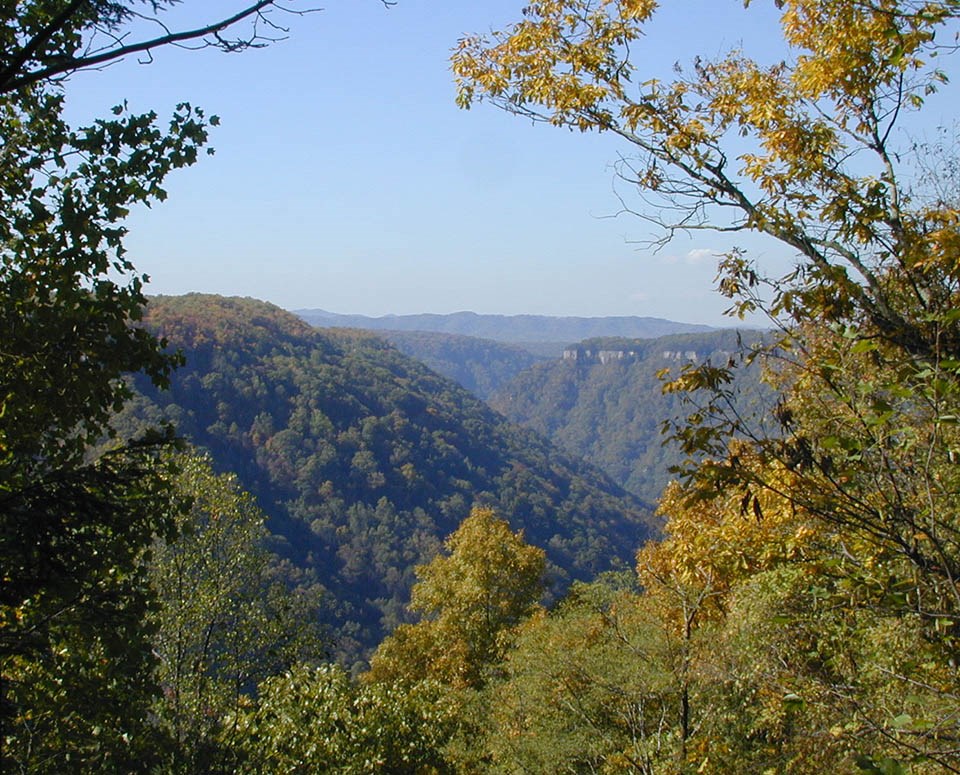
NPS
Within the New River Gorge National River (NERI), Gauley River National Recreation Area (GARI), and Bluestone National Scenic River (BLUE), understanding the current condition of park forests and how the forests are changing is critical to long-term management of park ecosystems. One reason that monitoring forest health is so important—the forests are constantly changing. Storms, pests, pathogens, drought, and new species all play a role in shaping the forest. Studying the different components of a forest gives the Eastern Rivers & Mountains Network (ERMN) information on the health of the forest, and allows park managers to make better informed decisions on how to manage the forest. In particular, mortality (how many trees are dying), recruitment (how many trees are growing into the canopy), and tree growth are important indicators of forest health and vitality.
“How are park forests changing over time in relation to weather, climate, landscape dynamics, invasive species, deer browse, and natural processes such as disturbances and succession?”
Ash Trees Hit Hard by Emerald Ash Borer
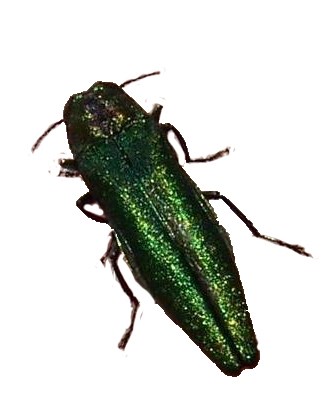
Many of the ash trees (Fraxinus spp.) in the parks have died in recent years as a result of the emerald ash borer, an exotic beetle that was likely brought to NERI on infected firewood. The beetle larvae (the immature stage) feed on the inner bark of ash trees, disrupting the tree’s ability to transport water and nutrients. As the ash trees become stressed, they produce many seeds in a last-ditch effort to reproduce. This effort appeared in our monitoring data as a disproportionately large amount of ash seedlings compared with the number of ash trees in the canopy. These seedlings are unlikely to survive to maturity unless an effective biological control for the borer is discovered. Park managers and visitors should be on the lookout for any surviving ash trees that may be resistant to emerald ash borer. And above all - DON’T MOVE FIREWOOD!

Wind Storms Wreak Havoc in Gauley River
In the summer of 2012, severe wind storms caused widespread damage throughout GARI, breaking and toppling many trees, even throwing tree trunks uphill! As a result of the storms, there are many more downed logs, which provide essential wildlife habitat and nutrients to the forest floor. The park’s standing living tree basal area also decreased. In other words, the storms blew down more trees in one day than trees grew in the park over four years! The gaps in the forest canopy created by wind storms are an important natural disturbance that increase light to the forest floor and promote tree seedling growth. However, exotic invasive plants also thrive in these gaps, threatening to crowd out native trees and wildflowers.
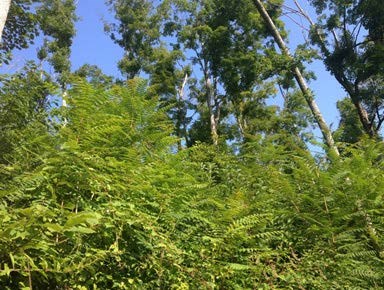
NPS / Doug Manning
Tree-of-Heaven Takes Root
The exotic invasive species Tree-of-heaven (Ailanthus altissima) is a serious threat to the parks, especially in storm-damaged forests or in canopy gaps left by dying ash trees. This prolific, fast-growing tree thrives in canopy gaps and can quickly form extensive stands, out-competing native trees. In parts of NERI, tree-of-heaven is the fastest growing species and has the most young trees entering the forest canopy of any species. Left unchecked, this species could drastically reduce the biodiversity of the park in the areas it invades.
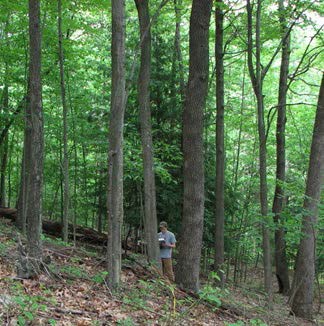
NPS / Doug Manning
New River Gorge's Hemlock Trees Hang On
Majestic evergreen hemlock trees grow in the parks’ ravines, mountainsides and on some rock outcrops. Over the past 15 years, the hemlock woolly adelgid, an aphid-like exotic invasive insect, has been feeding on the parks’ hemlocks, hiding on the underside of the needles and drinking the trees’ sap. ERMN monitoring data show that hemlock trees in NERI have solid recruitment, no observed mortality, and average growth, suggesting that hemlocks are persisting in the park despite the presence of hemlock woolly adelgid for many years. This is great news, however, back-to-back years of droughts and/or warm winters could cause significant stress to hemlock trees already strained by the adelgid. Park managers should continue monitoring the effects of treatments focused on protecting the hemlocks against the adelgid.
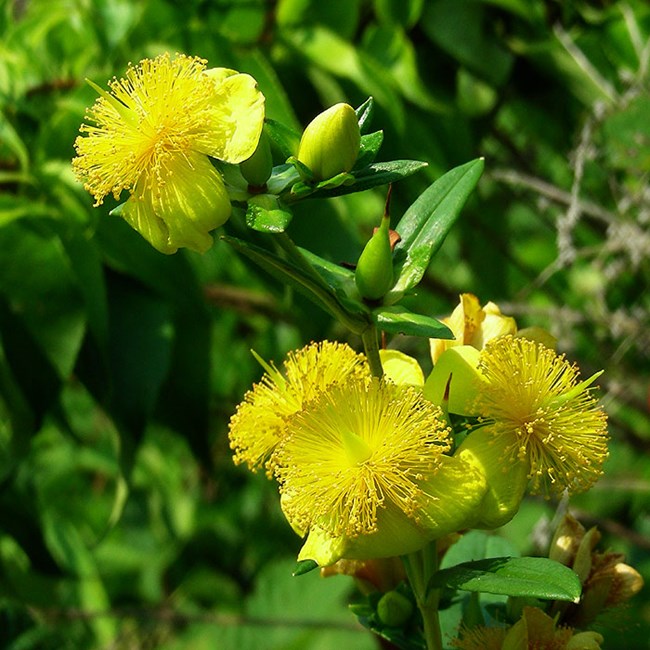
NPS / David Smith
It's Tough to be a Tree in Bluestone
Compared to other ERMN parks, forests in BLUE are having a tough time. BLUE’s forests have high tree mortality, low tree recruitment into the canopy, and the slowest tree growth. These forests are under stress from the relatively drier and droughty environment in BLUE compared to the other parks. Even though BLUE is relatively close to NERI on the map, BLUE falls in a different climate zone that receives less rain and has warmer temperatures on average. Also, the soils in BLUE don’t hold moisture very well, furthering the drought stress trees experience. The drier, droughty environment leaves the trees more susceptible to impacts from pests, pathogens, drought, and climate change. Park managers should anticipate that summer droughts and insects such as hemlock woolly adelgid, gypsy moth, and emerald ash borer may cause greater and/or quicker damage in BLUE than in other network parks.
For More Information
Contacts
Stephanie Perles
Plant Ecologist
814-441-9643
stephanie_perles@nps.gov
Matt Marshall
Program Manager
814-863-0134
matt_marshall@nps.gov
Webpages
Vegetation and Soils Monitoring
Eastern Rivers & Mountains Network
Report
Perles S and Others. 2016. Forest dynamics in national parks in the Eastern Rivers and Mountains Network.. Natural Resource Report. NPS/ERMN/NRR—2016/1182. National Park Service. Fort Collins, Colorado
Summary by the Eastern Rivers & Mountains Network, January 2016. Updated June 2018.
